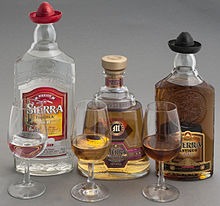**History and Recent Developments:**
– Tequila production introduced in mid-1700s, with Don Pedro Sánchez de Tagle as the first producer.
– Cuervo family granted first legal license for tequila production.
– Over 100 distilleries produce 900+ tequila brands in Mexico.
– Significant developments in the 2000s, including new tequila classes and export agreements.
– First tequila distillery in the U.S. opened in 1936.
**Production Process and Regulations:**
– Tequila production limited to specific Mexican states.
– Harvesting, baking, shredding, and distillation involved in the production process.
– Fermentation, yeast selection, and chemical processes crucial to tequila’s quality.
– NOM regulations enforce specific standards for tequila production.
– Tequila differentiated from mezcal by blue agave use and preparation methods.
**Cultural Significance and Protection:**
– Tequila region declared UNESCO World Heritage Site in 2006.
– Tequila has protected designation of origin status in various countries.
– Tequila must have 35-55% alcohol content and is commonly served neat or as a shot.
– Mexico enforces tequila protection through NAFTA and international agreements.
– Tequila is differentiated from mezcal by specific production methods and ingredients.
**Aging, Flavor, and Types of Tequila:**
– Tequila aging processes regulated by the Mexican government.
– Different types of tequila based on aging categories like Blanco, Reposado, Añejo, and Extra Añejo.
– Chemical transformations during aging impact flavor and aroma.
– Threats to quality include TMA blight and long maturation times affecting prices.
– Misconceptions like the tequila worm and its association with lower-quality products clarified.
**Market and Consumption Trends:**
– Tequila market includes over 1377 registered brands from 150 producers.
– Various serving traditions globally, from neat shots to cocktails.
– Tequila glasses like the caballito and margarita glass are commonly used.
– Regulations in countries like Canada and the U.S. ensure tequila authenticity.
– Related topics include mezcal, pulque, and other Mexican spirits, with tequila recognized as a protected product.
Tequila (/təˈkiːlə/; Spanish: [teˈkila] ⓘ) is a distilled beverage made from the blue agave plant, primarily in the area surrounding the city of Tequila 65 km (40 mi) northwest of Guadalajara, and in the Jaliscan Highlands (Los Altos de Jalisco) of the central western Mexican state of Jalisco.
 Three varieties of tequila | |
| Type | Distilled beverage |
|---|---|
| Country of origin | Mexico |
| Region of origin | Jalisco |
| Introduced | 16th century |
| Alcohol by volume | 38–55% |
| Proof (US) | 76–110° |
| Colour | Clear, brown or golden |
| Flavour | Sweet, fruity, earthy |
| Ingredients | Blue agave |
| Variants | Excellia |
| Related products | Mezcal, bacanora, raicilla, pulque |

The red volcanic soils in the region of Tequila are well suited for growing the blue agave, and more than 300 million plants are harvested there each year. Agave grows differently depending on the region. Blue agaves grown in the highlands Los Altos region are larger and sweeter in aroma and taste. Agaves harvested in the valley region have a more herbaceous fragrance and flavor. Due to its historical and cultural importance, the region near Tequila was declared a UNESCO World Heritage Site in 2006, the Agave Landscape and Ancient Industrial Facilities of Tequila.
Mexican laws state that tequila can be produced only in the state of Jalisco and limited municipalities in the states of Guanajuato, Michoacán, Nayarit, and Tamaulipas. Tequila is recognized as a Mexican designation of origin product in more than 40 countries. It was protected through NAFTA in Canada and the United States until July 2020, through bilateral agreements with individual countries such as Japan and Israel, and has been a protected designation of origin product in the European Union since 1997.
Aside from its geographical distinction, tequila is differentiated from mezcal in that it is made only from blue agave and the beverages are prepared in different ways. Tequila is commonly served neat in Mexico and as a shot with salt and lime around the world. Tequila must have between 35 and 55% alcohol content (70 and 110 U.S. proof).
